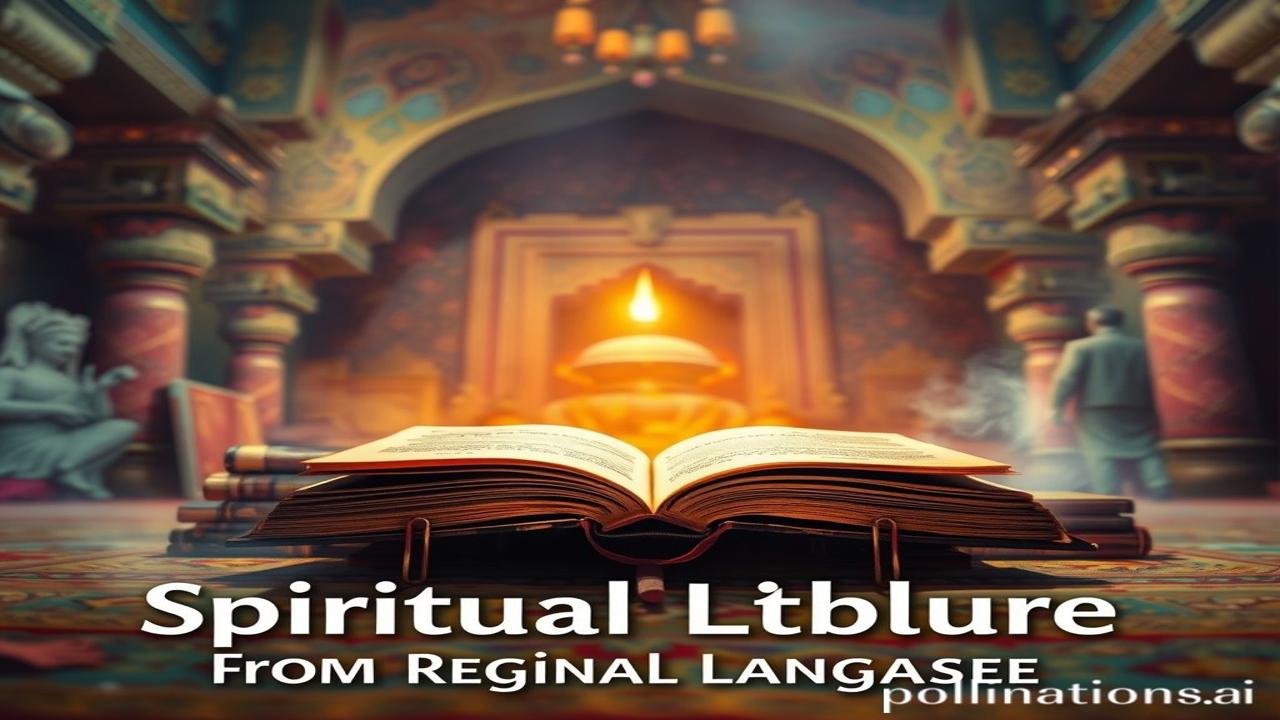Waqt ki Dhool Mein Chhupi Roshni: Spiritual Literature from Regional Languages
Kabhi socha hai, jab hum aaj apne modern digital screens mein doobe rehte hain, ki hamare purvajon ne kaise apne dil ki baat, apne mann ki shanti, aur apni bhakti ko likhkar preserve kiya? Woh eent ki deewaron par, taad-patron par, aur unke hridayon mein… Spiritual literature from regional languages is exactly that – a whispered secret from our collective past, a light shining through the dust of time.
Itihasik Prishthbhoomi: Roots in the Soil
What exactly are we talking about? Spiritual literature from regional languages is essentially religious and philosophical writing composed in languages other than Sanskrit or Hindi. Think Tamil, Telugu, Kannada, Marathi, Bengali, and so many more.
When and where did this all begin? Well, it’s difficult to pinpoint a single starting point. It’s more like a flowering, a gradual blossoming that began in the early centuries CE and continued to evolve over millennia. Different regions of India saw their own unique expressions of spiritual thought through poetry, prose, and drama.
Why is it so important? Because these works reflect the deeply rooted spiritual traditions of specific communities, their unique relationship with the divine, and their interpretation of universal truths. They are the saans (breath) of local culture, the dharkan (heartbeat) of regional identity. Think about it: The Bhakti movement, which emphasized devotion and love for God, flourished primarily through regional languages.
Zameeni Sach – Log Aur Jeevan: The Weavers of Words
Imagine life in a small village in Maharashtra around the 13th century. Sant Dnyaneshwar, a young man with a burning desire to share the wisdom of the Bhagavad Gita, decides to translate it into Marathi, a language spoken by the common people. “Arey baba! Sanskrit toh panditon ki bhasha hai,” he might have said. “Mere logon ko bhi toh Bhagwan ki baat samajhni chahiye!”
He sits by the banks of the Indrayani river, his fingers stained with ink, meticulously writing each verse. Farmers stop their work to listen to his recitations. Women carrying water pots pause to absorb the divine message. The air is filled with the fragrance of incense and the sound of Dnyaneshwar’s voice, weaving magic with words.
Or picture a Tamil poet, Andal, in the 8th century. She, a woman, dares to express her passionate love for Lord Ranganatha through her verses. Her words are bold, sensual, and deeply spiritual. She is not afraid to challenge societal norms and express her devotion in her own voice. “Prem toh prem hai, Bhagwan ke liye ho ya insaan ke liye,” she proclaims. Her poetry, known as the Thiruppavai, is still recited in temples across South India during the month of Margazhi.
These are just glimpses, mind you. Countless other saints, poets, and scholars poured their hearts out in their mother tongues, creating a rich tapestry of spiritual literature.
Dharohar Aur Pehchaan: Echoes of the Past in the Present
Today, we see the legacy of these regional spiritual works everywhere. Consider the popular Carnatic music compositions, many of which are based on the devotional songs of the Alvars and Nayanmars of Tamil Nadu. Or think about the abhangas of Tukaram and Namdev, which continue to inspire millions in Maharashtra.
Even in modern literature and art, we find echoes of these ancient traditions. Authors draw inspiration from these stories, artists depict scenes from these texts, and musicians reimagine the melodies. This rich literary heritage connects us to our Bharatiyata, reminding us of the diverse and vibrant spiritual landscape of India.
Mazedar Tathya Ya Bhram-Bhanjak: Did You Know?
Log samajhte hain ki Sanskrit hi sabse pavitra bhasha hai, aur usme likhi hui cheezein hi spiritual hoti hain. Lekin asli sach yeh hai ki हर भाषा पवित्र हो सकती है अगर उसमे प्रेम, भक्ति, और सच्चाई हो। Regional languages, with their raw emotions and direct connection to the local culture, have often provided a more accessible and relatable path to spirituality for the common people.
Drishya Aur Bhavanaen: A Sensory Tapestry
Imagine yourself sitting in a small temple in a village in Karnataka. The air is thick with the smell of sandalwood and jasmine. The temple walls are cool to the touch. The sounds of chanting and the ringing of bells fill the air. You can feel the vibrations of the divine energy all around you. This is the atmosphere that nurtured and inspired the creation of much of this regional spiritual literature.
Antim Vichar Ya Uddharan: A Lingering Thought
This spiritual literature, born from the earth and infused with the spirit of the people, reminds us that the path to the divine is not confined to a single language or tradition. It is a journey that can be undertaken in any language, with any heart, and from any corner of this vast and beautiful land.
“सर्वस्य चाहं हृदि सन्निविष्टो मत्त: स्मृतिर्ज्ञानमपोहनं च।” (Sarvasya chaham hrdi sannivishto mattah smritir jnanam apohanam cha)
– Bhagavad Gita (15.15)
(I am seated in everyone’s heart, and from Me come remembrance, knowledge, and forgetfulness.) This verse reminds us that the divine resides within each of us, regardless of the language we speak or the scriptures we read. The journey inwards, fueled by love and devotion, is the true essence of spirituality.
